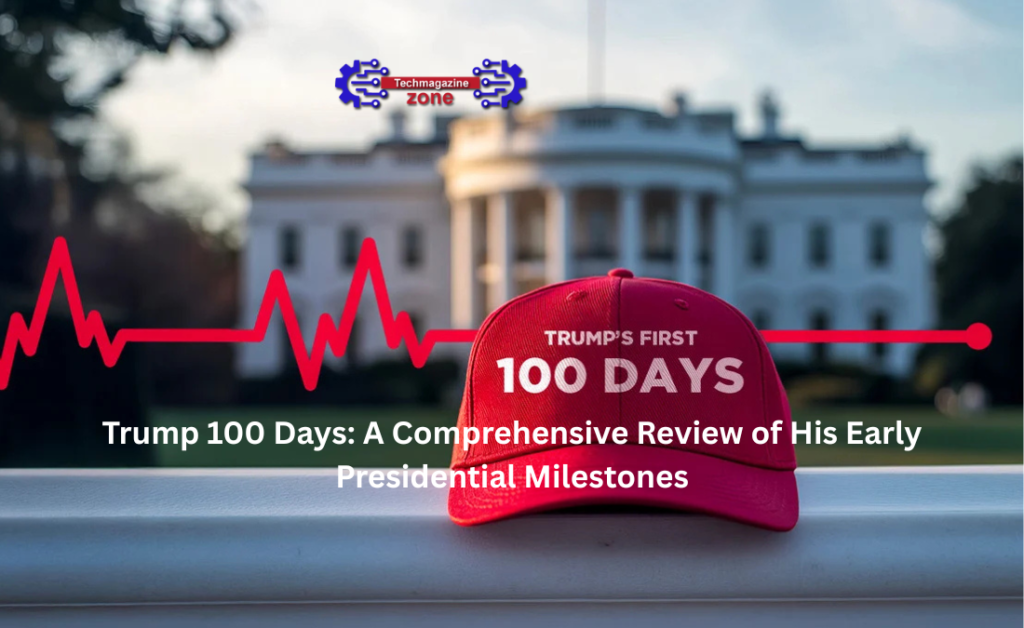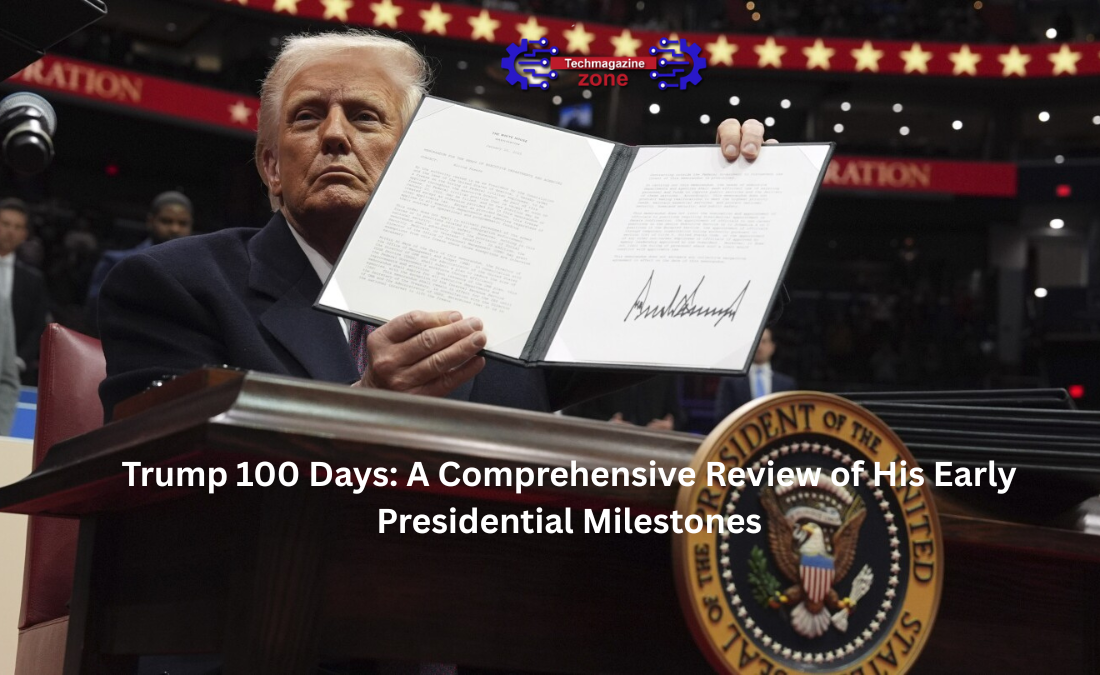The first 100 days of any U.S. president’s term are often viewed as a critical period that sets the tone for the rest of their administration. When Donald J. Trump took office as the 45th President of the United States on January 20, 2017, the world watched closely. Promising to “Make America Great Again,” President Trump’s agenda included sweeping reforms in immigration, healthcare, trade, taxation, and foreign policy. This article offers a detailed exploration of Trump 100 days, analyzing his accomplishments, challenges, and political strategy.
Introduction to Trump 100 Days Agenda
From the beginning, the Trump 100 days plan was ambitious. In a “Contract with the American Voter” released before the election, Trump laid out 28 promises he aimed to act upon during this early period. His priorities included:
- Repealing and replacing the Affordable Care Act (Obamacare)
- Implementing tax reform
- Revamping immigration policy
- Renegotiating trade deals like NAFTA
- Nominating a conservative Supreme Court justice
The scale and urgency of this plan made Trump’s first 100 days one of the most closely scrutinized early presidencies in modern history.
Trump 100 Days: Immigration Policy Changes
Immigration was perhaps the most aggressively pursued item during the Trump 100 days. One of his first executive orders, issued on January 25, 2017, was aimed at building a wall along the U.S.-Mexico border and increasing deportations of undocumented immigrants. Shortly after, he issued the controversial “travel ban” targeting citizens from seven Muslim-majority countries.
While the ban was met with immediate protests and legal challenges, it symbolized Trump’s commitment to his base and his broader immigration strategy. During the Trump 100 days, he also expanded the role of Immigration and Customs Enforcement (ICE), leading to a sharp rise in arrests of undocumented immigrants.
Trump 100 Days: Healthcare Reform Efforts
One of Trump’s core campaign promises was to repeal and replace Obamacare. However, despite Republican control of both the House and Senate, the Trump 100 days were marked by failure to deliver on this front.
The American Health Care Act (AHCA), the Republican alternative, was introduced in March 2017 but faced opposition from both moderate and conservative Republicans. The bill was withdrawn before a vote could take place, marking a significant setback for Trump’s legislative agenda.
This failure during the Trump 100 days demonstrated the complexities of navigating Congressional politics—even with a Republican majority.
Trump 100 Days: Tax Reform and Economic Policy
While no major tax reform legislation was passed during the Trump 100 days, the administration did unveil the outline of a sweeping tax plan. This included:
- Reducing the corporate tax rate from 35% to 15%
- Simplifying individual tax brackets
- Eliminating the estate tax
The plan was short on details but highlighted Trump’s focus on growth through tax cuts and deregulation. During this period, Trump also signed several executive orders aimed at reducing regulations, particularly in the energy sector.
Trump 100 Days: Trade and Foreign Policy Shifts
Trade was another key focus during the Trump 100 days. On his third day in office, Trump withdrew the U.S. from the Trans-Pacific Partnership (TPP), a 12-nation trade pact negotiated by the Obama administration.
He also initiated steps to renegotiate NAFTA, signaling a shift toward more protectionist trade policies. Trump’s meetings with leaders from China, Canada, Japan, and the UK during his early days showed a deliberate pivot in U.S. foreign relations—favoring bilateral over multilateral agreements.
On foreign policy, the Trump 100 days were notable for a missile strike in Syria following a chemical weapons attack. This was a significant action that drew both praise and criticism, as it marked a departure from Trump’s earlier isolationist rhetoric.
Trump 100 Days: Judicial Appointments
A key win during the Trump 100 days was the successful nomination and confirmation of Neil Gorsuch to the U.S. Supreme Court. Gorsuch’s confirmation restored the court’s conservative majority and was viewed as a major political victory for Trump and the Republican Party.
This appointment had a long-lasting impact and fulfilled one of Trump’s most important campaign promises to his conservative base.
Trump 100 Days: Deregulation and Executive Orders
Trump’s use of executive orders during his first 100 days was prolific. He signed more than 30 executive orders—more than any other president since World War II during the same period.
These orders covered a wide range of issues, including:
- Rolling back Obama-era environmental regulations
- Expanding offshore drilling
- Directing a review of the Dodd-Frank financial regulations
- Calling for a “Buy American, Hire American” approach in federal projects
Through these actions, the Trump 100 days marked a clear shift toward deregulation and business-friendly policies.

Trump 100 Days: Public Opinion and Media Response
The Trump 100 days were polarizing. According to Gallup, Trump had the lowest approval rating of any modern president at the 100-day mark—just 41%.
Much of the media coverage was critical, focusing on the administration’s missteps, internal conflicts, and the Russia investigation, which began during this period. Still, Trump maintained strong support among his base, who viewed his confrontational style and policy moves as evidence of real change.
Trump 100 Days: Legislative Achievements and Challenges
Despite Republican control of Congress, the Trump 100 days were marked by a lack of major legislative achievements. The failure to repeal Obamacare, delays in tax reform, and internal GOP divisions pointed to significant governing challenges ahead.
However, Trump did succeed in passing 28 bills into law during this period—more than President Obama (14), George W. Bush (7), and Bill Clinton (24) in their respective first 100 days. Many of these were symbolic or minor, but the volume showed a fast-paced executive agenda.
Trump 100 Days: Impact on International Relations
International reactions to the Trump 100 days were mixed. While allies were cautious, adversaries watched with interest. His “America First” foreign policy raised concerns among traditional partners in NATO and the European Union.
At the same time, Trump’s unexpected decisions—like the strike on Syria and stern warnings to North Korea—signaled unpredictability in U.S. foreign policy. This uncertainty defined much of the international perception of the Trump presidency.
Trump 100 Days: Key Takeaways and Historical Comparisons
When comparing the Trump 100 days to those of past presidents, several distinctions emerge:
- Boldness in executive actions: Trump was unafraid to use executive orders to push his agenda.
- Partisan challenges: Even with a Republican Congress, he struggled to unify the party.
- Unconventional approach: Trump’s communication style, especially on Twitter, broke from presidential norms and dominated headlines.
Historically, presidents such as Franklin D. Roosevelt and Ronald Reagan used their first 100 days to implement major changes. While Trump made notable moves, his legislative struggles and chaotic communication often overshadowed policy.
Conclusion: The Legacy of Trump 100 Days
The Trump 100 days were a whirlwind of action, controversy, and bold rhetoric. While he made headway on immigration and judicial appointments, he struggled with healthcare reform and tax legislation. His aggressive use of executive orders, dramatic foreign policy moves, and relentless media battles defined his early presidency.
Though critics argue that he failed to deliver on several promises, supporters contend that he shook up Washington and pursued his agenda with vigor. Ultimately, the Trump 100 days set a confrontational, disruptive tone that would characterize the rest of his presidency.
In hindsight, these 100 days offer a critical lens into the priorities, strengths, and limitations of Donald Trump as president—and into the deeply divided political climate of the United States in the early 21st century.Tools
